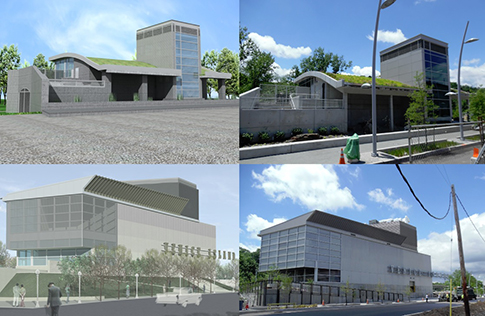
Renderings (at left) of the Performing Arts Center and Head House compared to the finished buildings, at right. Image credit: Hazen and Sawyer.
We’re extremely proud of the way Philadelphia Water’s construction team and engineers made what was once just a grand idea—the Venice Island Performing Arts and Recreation Center—into a reality.
It’s hard not to admire their work when you see that sloping, living green roof from Main Street in Manayunk, and it gets even better when you explore the facility up close.
So, it’s no surprise that the work at Venice Island, which was completed at the end of 2014, was just named “Environmental Project of the Year” by the Construction Management Association of America’s Mid-Atlantic chapter. The award was presented for the “Manayunk Venice Island Sewer Basin Construction/Performing Arts and Recreation Center Reconstruction” on June 2 to Philadelphia Water and Hazen and Sawyer, the project’s designer of record.
“This award recognizes Philadelphia Water’s role in providing construction management services that promoted professionalism in the construction process and resulted in a successful project,” said Philadelphia Water Construction Manager Bob Rotermund. “Our team, led by Jim Giffear and Attasit Kaewvichen, kept the project within budget and on schedule.”
Giffear, a Division Engineer in Philadelphia Water’s Construction Branch, said the project was a special one because it brought so many positive changes to the area, which sits between the Manayunk Canal and the Schuylkill River.
“We were able to construct a facility which serves to protect the Schuylkill River from combined sewer overflows during large storm events, while at the same time providing an amazing recreation and entertainment space for the citizens of Philadelphia,” said Giffear. “[Philadelphia Water Commissioner] Howard Neukrug was instrumental in creating the partnerships between the various city agencies and community groups necessary for Venice Island to become a reality.”
Giffear said this award reflects Philadelphia Water’s commitment to quality management of its construction projects, community engagement, and partnerships with city agencies.
“What makes this project unique is the construction of a true multiple-use site. On one side of the island sits a wastewater pumping station, underground is a 4 million gallon basin, and up above houses basketball courts, an outdoor amphitheater, children’s spray park, and a 250-seat performing arts center, with public parking throughout,” said Giffear. “The CMAA award is in recognition of the technical and logistical challenges faced by such a multifaceted project, and the teamwork, professionalism, quality control, and communication necessary to make it a success.”
That CMAA highlighted the environmental aspects of the Venice Island work also speaks to Philadelphia Water’s commitment to green stormwater management initiatives and environmentally conscious building materials and methods, Giffear also noted.
Leo Dignam, deputy commissioner for programs at Philadelphia Parks and Recreation, said the Performing Arts Center has also been a huge hit.
“We are thrilled at how it turned out and have been booked almost from the day we took over,” said Dignam. “The outside space and environmental features are extraordinary and go above and beyond what we would ever have been able to do on our own. I think this project is a model of the way city departments can coordinate with the community.”
Some Green Highlights from Venice Island:
• Countless sustainable site and building features throughout Venice Island. The basin, in addition to being an environmentally focused infrastructure improvement, includes a pump station which is LEED eligible. The building is furnished with a high-tech window system that makes maximum use of natural light and reduces heat gain, promoting energy efficiency in the facility. Atop the pump house sits a green roof containing drought tolerant plant species which minimize the stormwater impact of the building.
• The site features numerous green design components. There are several rain garden systems which collect street-level stormwater runoff and allow it to slowly infiltrate in place, before returning it to the sewer system. Boulders were reclaimed from earlier excavation activities and repurposed for landscape features. Additionally, the site lights are all low voltage LED fixtures, which are controlled by photocells and are only illuminated when necessary.
• The Performing Arts Center likewise contains numerous sustainable design features, such as a green roof. Stormwater that falls on the building is collected and stored in “graywater” holding tanks. That captured stormwater is then reused in the facility for non-potable applications.
Hazen and Sawyer’s Work at Venice Island
As “designers of record” at Venice Island, Hazen and Sawyer designed an innovative, LEED Silver-eligible structure to house the equipment associated with the Combined Sewer Overflow (CSO) detention facilities, comprised primarily of a concrete basin that receives flows by gravity when the adjacent interceptor becomes surcharged during storm events. The CSO detention basin was constructed underground, with public parking and facilities redesigned and restored atop the basin.
The Head House that sits atop the basin is a LEED Silver-eligible building with numerous energy-saving and sustainable design measures.
Hazen and Sawyer’s design includes a “living” roof system with drought-resistant plantings; rain gardens throughout the site to manage storm water runoff; a glass stair tower to allow light to enter all sides of the building and reduce the need for interior lighting; light and occupancy sensors for energy efficiency; shade and reflection devices for sun control that reduces the need for air conditioning; and water-conserving plumbing fixtures.
Award Acknowledgements: Philadelphia Water Commissioner Howard Neukrug, Robert Rotermund (Manager, Construction Branch), Mike Lavery (Manager, Design Branch), Attasit Kaewvichien (Division Engineer, Construction Branch), Tony Kopicki (Asst. Manager, Construction Branch), Jim Giffear (Division Engineer, Construction Branch) and Anant Rao (Electrical Engineer, Construction Branch)